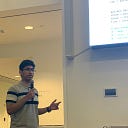How Genetic Variants (SNPs) Affect Drugs Response
What if I told you that in a biochemical sense, you are 99.9% similar to every single other person in the world. Well… that wouldn’t make much sense.
It’s practically the same as having a 4-page story with only two words changed. Say I gave you two copies of the stories, one being the original, and the other having a two-letter substitution. Your eyes would scan the paper through a more qualitative lense. Obviously, these essays would be essentially indistinguishable to you. They’d consist of the same characters, themes, and plots. Anyway, how could a two letter change determine that one story is fundamentally better than the other, right?
But… that’s not exactly how our genetic codes. Although our DNA, consisting of the 4 letter nucleotides (A, C, G, and T), is 99.9% similar to the person next to us, that remaining 0.1% is what makes us unique. Now, when I say “unique”, you’re probably thinking of physical characteristics, like height, weight, eye color, and skin color… It’s true: the 0.1% does explain variation in these characteristics… But it goes way beyond trivial features like those, extending to more fundamental aspects of our day to day lives.
For the past few centuries, medicine has been one of humanity’s more primary concerns. Centuries ago, plagues wiped out large portions of countries’ populations, and with no medical treatments or small molecule drugs, all people could really do was sit and watch as debilitating symptoms decimated their neighbors, friends, and families.
But now that’s not the case. The human healthspan has dramatically increased by thirty to forty years and we’ve made hundreds of small molecule drugs that treat or potentially cure a large variety of diseases. With vaccines, we’re able to stop viral infections before infections spread, thereby solving the problem at its root.
TL;DR Our approach has been pretty successful so far.
But we’ve hit a roadblock.
SNPs or single nucleotide polymorphisms are simple one-letter mutations in our genomes. While some can be innocent single letter changes that don’t visibly affect bodily function, others act can cause harmful symptoms and conditions that affect all parts of the body. Unlike the example from the beginning, a change in only one nucleotide can affect a large range of physiological processes. Here’s the key difference though; some of these SNPs act in bright daylight, while other SNP ninjas secretly act in darkness and complete secrecy.
If we thought of our genome as a map, one type of harmful SNPs would reside in bustling cities, the ones that manufacture thousands of mutated proteins for our bodies’ cells in what is called the “coding” region of the genome. On the other hand, the silent SNP ninjas would inhabit the vast oceans and deserts of the genome, the non-coding region, secretly conspiring and commanding the other SNPs about when, where, and how to carry out their harmful plans.
Right now, with most small molecule drugs, scientists have been targeting the SNPs that are acting in plain sight. (Read this article to find out how) And this might seem like the right solution since these are the SNPs that are the ones that actually produce mutated proteins. But the other kind of SNPs that vary from person to person, the ones hiding in the non-coding region, plot for revenge. Therefore, when some patients take drugs, their illnesses aren’t cured, and sometimes, they get even worse.
This is likely one of the oversights contributing to the double in Adverse Drug Reactions (ADRs) and a predicted exponential rise in the number of patients for certain diseases.
The only way that we could solve this problem is by looking at specific non-coding elements of our genome, and understanding how they regulate drug response.
eQTLs
Normally, when drugs are developed, scientists see the disease phenotypes as a causal endpoint. The main goal is to backtrack from the disease phenotype to find a causal variant in the genome of the patients. The first causal variant that is often found is a coding SNP. The coding SNP leads to a dysfunctional protein that wreaks havoc in the cell. And it ends there.
But there’s more. The coding SNP leads to a dysfunctional protein and pathway, but it doesn’t dictate how much of the gene is transcribed. Another SNP that’s in a location called an expression quantitative trait loci acts more like a volume switch turning up the volume or turning down the volume on a gene that’s being transcribed.
It’s important to remember that the SNPs within eQTLs (eSNPs), vary from individual to individual. Since eQTLs reflect the ways in which genes can talk to each other, genes can be regulated differently in different individuals based on their own specific eSNP variants.
By constructing gene regulatory networks, which take into account the multiple genes involved in a disease along with the eQTLs that regulate them, we could more effectively personalize medicine to each individual.
Here’s what I mean
If you had two individuals (A and B) who have the exact same coding SNP and the same “key driver gene” that leads to disease symptoms.
The only difference between the two individuals is that Individual B lacks an eQTL that modulates the expression of the key driver gene. In other words, since the eQTL locus and the key driver gene can’t “talk” or communicate with each other, the drug is ineffective. The worst part is that the patient would both experience the symptoms of the disease and side effects associated with the drug without any relief.
Thanks for reading! Feel free to check out my other articles on Medium and connect with me on LinkedIn!
If you’d like to discuss any of the topics above, I’d love to get in touch with you! (Send me an email at mukundh.murthy@icloud.com or message me on LinkedIn)
Please sign up for my monthly newsletter here if you’re interested in following my progress :)
